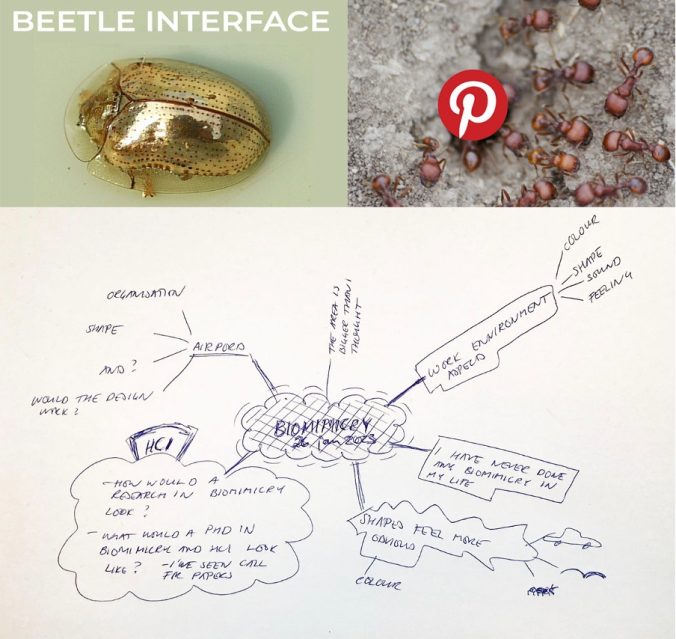Jonathan Källbäcker and I attended the Applied Human Factors and Ergonomics 2024 conference in Nice, France during the summer. The tasty seafood and baked goods found in the region aside, we were there to present a paper in the AROA-project. The conference was held at Campus St Jean at Université Côte d’Azur over four days and consisted of about 150 sessions of about five to seven presentations each split across 42 tracks and about 100 posters. Since it was not possible to attend all the sessions (I only got around to 12 of them), I chose to prioritize sessions related to work and AI.

This blog post consists of my pick of three highlights of the conference in the order of their sessions occurred, some issues with the conference format and how I would try to work around them if I organised a conference in the future, and a summary of the paper we presented on the conference. With a conference of this size, this will not be much more than a snapshot of it.
Highlights as an Attendee
During the session on Human factors in game design, Andrade (2024) presented on the placement of buttons in video game ads and the consequences of placing buttons outside of a handheld devices’ functional area. The functional area is often discussed as the space where buttons should be placed on handheld touch screens to make sure that they are reachable, but the design literature I have used in teaching rarely boggle down into the actual consequences of and reasons for placing buttons outside of it. The presentation discussed how this deliberate design choice makes the button hard to reach which increases the time needed to press the button and the duration of the ad that was viewed. It also causes a lot of strain and ads in free mobile games are common and often require multiple button presses. While the presentation was not related to AI or work, it was a highlight of the conference as it was an interesting and well-presented while contextualising and giving very practical and clear implications for a heavily discussed but maybe often-overlooked design principle.
The title of the session Individualization of services using Generative AI was a bit misleading as most presentations of the session were about the future of technology in some way. The session was packed with interesting topics, such as Grosch (2024) and Haase (2024) presented on future skills, Stübinger (2024) discussed how students would use generative AI in their work processes, Kröckel (2024) presented a literature review on how Generative AI can redefine emergency services, and Nhi et al. (2024) looked at awareness of environmental impact and willingness to reduce behaviours of video stream consumption. While the session overall gave a promising view of our adaption for the future, the presentation by Nhi et al. (2024) was one of the strongest presentations I attended as it conveyed its research gap and takeaway points very well, had a clear and visually interesting set of slides, while managing to portray their research in ways that anyone could understand.

The last highlight was the session Digital Dynamics in the Workplace, Exploring AI Integration, Flexible Work Models, and Participatory Design. The presenters were mainly from ifaa (it apparently translates to Institute for applied work science) in Germany and they were doing a lot of interesting research on work design and designing for work processes which turned out to be an interesting angle of approach compared to the workplace studies that we are doing in the research project I am in. The presentations included interesting things such as the need of workers in public administration (Maibaum et al. 2024), Socio-technical success factors for AI-based knowledge management (Reyes et al. 2024) and work design of chipping production (Weber et al 2024).
Conference Format Issues and Possible Workarounds
The main issues we experienced with the conference was due to the hybrid format and with the scheduling. The conference was hybrid and a lot of presenters were presenting and attending remotely. This was done through a video conference tool which a volunteer moderated by allowing participants to screen-share and such. We watched the keynote remotely on our way to the conference and but the conference call only had the slides being shared, not the audio so we didn’t hear what was said. Multiple attendees wrote about this in the chat but no one took note of it. When we arrived at the conference, we noticed the same issues taking place. The audio from the conference was often not turned on in the conference call and when it was, the microphones were not working well with the presentation set up and often cut out. Attendees wrote about it in the video call chat during those sessions as well, but the volunteers were not tasked with keeping up with the chat in the video call and often left the room during the presentation which made them not aware of the issues. By using proper microphones for such type of usage, having the volunteers be active in the video call chat, and preparing a cheat sheet for how to fix audio issues for the volunteers would have solved a lot of issues with the hybrid format and improved the participants experience of the conference.

The other issue was that the scheduling of the sessions was at times uneven and the lack of breaks between the afternoon sessions caused sessions to run into the time slot for the following session. Each day was split into four time slots for sessions. The third time slot each day was only 60 minutes while the rest were 90 minutes. That being said, multiple sessions in the third time slot had 6 or 7 presentations of 10 minutes each while some of the 90-minute sessions only had 4 or 5. By either prolonging the 60-minute session to 90 minutes or by adjusting the number of presentations in those slots to fit within the time allotted to it, you would reduce the number of clashes and delays experienced. This is issue was further worsened by the lack of a break between the third and fourth time slot which made it impact the fourth slot even more. Adding a short break between those session would have reduced the amount of clashed and allowed people the time to move from one session to another.
We presented a paper
As you might be aware, we are working with a project on digital work engagement in which we are studying the impacts of automation, robotisation, and AI on work engagement in different domains with the aim to synthesise a framework on working towards digital work engagement. During the conference, we presented our initial findings from a workshop with our reference group regarding enabling technologies and work engagement (Bergqvist et al 2024). The members of the reference group got to discuss challenges and opportunities with enabling technologies within their domains as well as challenges and concerns regarding work engagement. Some of the main takeaways included that while the potential financial impacts of automation, robotisation, and AI in the work place are many and easy to imagine, we cannot forget about the concerns regarding sustainability, inequality, fear of lack of competence, and job displacement that exist in the work force. We need to continue to look into strategies to prevent discrimination induced and enforced by technology and continue to study the societal impacts that these technologies bring with them into the work place, society, and humanity.
We are also happy to say, if you haven’t heard about it yet, that we got the best paper award in the category of Challenges with AI at the Human Level.
The project is financially supported by Afa Försäkringar.
References
Andrade, W. M. (2024). Designing Mobile Game Input Unreachability: Risks When Placing Items Out of the Functional Area. Human Factors in Virtual Environments and Game Design, 126.
Bergqvist, A., Källbäcker, J., Cort, R., Cajander, Å., & Lindblom, J. (2024). Towards a framework for digital work engagement of enabling technologies. Artificial Intelligence and Social Computing, 257.
Grosch, C. (2024). Developing Future Skills through a Sequential Module Structure and Practical Orientation: A Case Study of the Bachelor Program in Applied Digital Transformation. Health Informatics and Biomedical Engineering Applications, 185.
Haase, S. (2024). Future Skills and (Generative) Al-New Era, New Competencies?. Health Informatics and Biomedical Engineering Applications, 178.
Kröckel, P. (2024). Redefining Emergency Services with Generative AI: Insights from a preliminary literature review. The Human Side of Service Engineering, 143(143).
Maibaum, M., Weber, MA, & Stowasser, S. (2024). Participatory Approaches to Design Work in the Context of Digital Transformation: An Analysis of the Needs of Employees in Public Administrations. Human Factors and Systems Interaction, 85.
Nhi, D. T. T., Chuloy, M., & Glomann, L. (2024). Environmental Impact of Video Streaming from Users’ Perspectives. Health Informatics and Biomedical Engineering Applications, 192.
Reyes, C. C., Ottersböck, N., Prange, C., Discher, A., Peters, S., & Dander, H. (2024). Technical and Socio-Technical Success Factors of AI-Based Knowledge Management Projects. Human Factors and Systems Interaction, 154(154).
Stübinger, J. (2024). Beyond Traditional Boundaries: The Impact of Generative Artificial Intelligence on Higher Education. Health Informatics and Biomedical Engineering Applications, 160.
Weber, J., Weber, MA, & Stowasser, S. (2024). Work design in production: Foundations and recommendations for the implementation of mobile, time-flexible work design in chipping production. Human Factors and Systems Interaction, 59.










